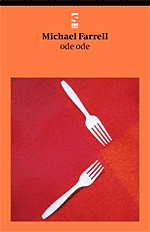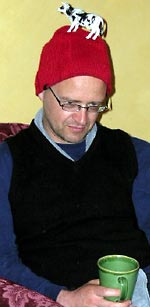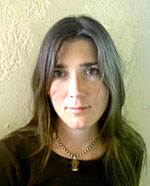BOOK REVIEW
Liz Parsons reviews
ode ode
by Michael Farrell
Salt Modern Poets, Cambridge UK, paper, GBP 8.99, USD 14.99, ISBN: 1876857536. Read about the book on the publisher’s site
This review was first published in JASAL Vol.3 2004. It is 1340 words or 4 printed pages long.
Chic lit
Michael Farrell’s first collection of poetry, ode ode, is erudite chic. The disjunctive front cover photograph with two white plastic forks on (roll out the) red carpet is revisited in poems which nod to lyrics by Tammy Wynette and Guns and Roses, intertwined with references to Genet, Darwin and Duchamp. The permutations and combinations of pop culture, high-art and philosophical ruminations ricochet across urban landscapes, lives, and relationships in ways that intersect with the objectives of L=A=N=G=U=A=G=E poetry. Charles Bernstein and other poets of that school claim that “reference, like the body itself, is one of the horizon’s of language, whose value is to be found in the writing (the world) before which we find ourselves at any moment.[1]
[1] Bruce Andrews and Charles Bernstein (eds), The L=A=N=G=U=A=G=E Book, Carbondale and Edwardsville: Southern Illinois UP, 1984. p ix.
Farrell seems to share this preoccupation with exploring the ways in which meaning is realized so that his deliberately artful poems, scanning across art objects and subjects, have poetic outcomes that are more than the sum of their intertexts. The almost compulsive references shape the vision of the poetic consciousness, and because Farrell’s slices of life are cut mandolin fine, the poems are translucent, fragmentary, often devoid of narrative and always without the luxury (or the cobwebs) of grammar.
These devices indicate “a provo/ cative way with the medium”(3). Provocations include not only the lack of grammar, but highly disjunctive and often obscure use of line breaks which abandon denotative and connotative functions of words in favour of half swallowed or choked sounds. The use of equally a-grammatical French, Italian and invention move language beyond meaning and toward texture. The stylistics are invitations to readerly involvement. Engagement with art operates both within and without, being central to the poems’ construction as well as a crucial tool in the reading process. Besides throwing down this intellectual gauntlet, the failure of (traditional forms of) language to encapsulate experiences becomes a fascination with type-set symbolism and audible dissonance. The poetics of alterity are exceeded by fixated games with language that consistently mark Farrell’s work. Obsessions worthy of Walwicz manifest themselves in stutters, beginning with the doubled title, ode ode, which signals the self-reflexive notion of an ode on an ode, and is mirrored by the front cover’s doubled forks that imply the conspicuous absence of the knife.

Such resistance to the logic of expectations is part of the disjunctive montage but also readable as a stammer, an obsessive repetition. It is unsurprising then that many of these poems glitch like a Yasunao Tone record. In “Pretty Pennies” line endings like: “more obedient than desira/ desirable a woman cuts grass,” break words to stall the flow of reading. Such scratches in the record impose temporary cognitive set-backs and repetitions. This is particularly apt because, in audio terms, glitches are caused by reading errors (technology reading the sound recording incorrectly) and poems like “track listing” extend that metaphor. But the insecurity of the stutter evolves in Farrell’s poems into a more confident demand that the reader decode the other possibilities of the slippage before continuing.
Despite this confidence there remains a suggestion of the return of the repressed. In “Pretty Pennies” this seems to pivot on anxieties associated with long term relationships. The fault-lines that cause tremors are at: “de/ decade”, “mar/ married”, “be/ began”, “e/ eventually” and “desira/ desirable”. The failure of love punctuates much of the intellectual cleverness of Farrell’s works. The poems are most often cerebrally emotive and, in works like “living at the z”, examined through the lens of popular culture. This poem takes the conceit of a shared video library membership card as emblematic of relationship cohesion and breakdown in a gesture that is almost joking. Numerous like moments of jocularity heighten the stutter’s sense of imperfect camouflage for deeper feeling. The opening line of the second prelude, “far from ok,” is the smirking: “I was born ok and raised there”. Equally, titles like “the tortoise who mistook a pickaxe for love” seem to seek some comic separation from painful experiences.
But this humour is equally an invitation to play, a reading that can also be applied to the word breakages as a private mode of cryptology. Such stylistics require re-associations in ways that are arguably political. Sapir [2] says that the ‘real world’ is unconsciously produced by the language habits of the group.
[2] Edward Sapir, 1884–1939, U.S. anthropologist and linguist, born in Germany.
It seems that Farrell both recognizes and resists this logic by refusing well-worn habits in order to speak anew the conditions for contemporary existence. The anagrams and un-grammar are only one level of this impulse. Another is that the collection takes the contradictory starting point of 5 codas.
Classical music codas produce the anticipation of resolution. They commonly play out an extended dissonance that increases in intensity until subsumed into the consonance of closure. Farrell’s codas are thus displaced. Beginning with multiple endings, the challenges to grammar are, at this point in the collection, literally brought to the fore in the form of titles. The five codas are each assigned a punctuation mark and the grammatical symbol marks the poem by a subtle suggestion to readers to replace that symbol’s absence in each work. In the first poem, the apostrophe (and its absence) shifts in and out of various manifestations including the genitive (ownership, possession or belonging), and substitution. The apostrophe is also a form of separation, a sense that is compounded by the visually indistinguishable (when the symbol stands alone without text as it does in this title) comma.
Ellipsis inflects the second work as pauses, elisions, while the dash which names the third poem is an absent hyphen from words cleft at line ends. It is also the dash that creates the pausing Emily Dickinson trademark, and perhaps the underscore that indicates emphasis. These codas ostensibly describe films in a festival and their intersection with the filmic grammar of editing is equivalent to splices and montage. But the first line of the first coda, “this is cinema made by people”, is also an invitation to view this collection of poems as collaborative films, a metaphor that serves them exceptionally well. The poem with a question mark title asks about both filmic and poetic ways of seeing in the same question:
some people are deaf to imagery
i include black & white screens
in this punctuation & imagery
piety & sanctity youve got to
hate to make a movie show it
dont say it art can be an is
land or asteroid even a milk
delivery if it backs through a
delicate situation glass isn’t glass
its whats distorted through it
the beauty of metaphors lie
lie lie silence can be hard to
watch quote me quote me oh
The quotes are hard to stop because the voice, like the relentless movie reel, does not pause for breath.
Despite references to Hollywood stars like Julia Roberts and Bogart in these codas, Farrell’s schematics are closer to avant garde experimental filmmakers like Jan Svenkmejer and Shinya Tsukamoto. Farrell says “the divines become an apostrophe/ in the mainstream in the arthouse” and in terms of his own poetry, each sense of apostrophe refigures this claim.
For all this complexity, in rare places the poems are equally compelling for their simplicity. The title poem is as bare as the sadness it annunciates and somehow transcends the cliché of “breaking hearts”. In place of 5 lines there are long dashes during which the reader waits for the next break on the beach. When they come they are repetitions like the title and the cheap plastic forks, but, as Minimalists discovered, repetitions are never the same, the context of the repetition relentlessly recodifies the second (and third and fourth) impressions in multifarious ways. Yet the poem is not minimalist. The back cover of this collection calls Farrell a new stylist, but just how to categorize his style is less obvious. Experimental, intellectual, referential, the adjectives jostle, unsettling each other. The final poem says “my audience is smaller than his monarchs” and perhaps the privilege of such a select group, well read and conscious of experimental and avant garde precursors, will necessarily delineate the market for this artful new book.

Michael Farrell
Poet Michael Farrell was born in Bombala, NSW in 1965. His poems have appeared in the anthologies Picador New Writing 3 and Calyx 30 Contemporary Poets (Paper Bark Press); he received the 1999 Harri Jones Memorial Prize. He has lived in Melbourne since 1990 and is the Australia editor for slope (www.slope.org).

Elizabeth Parsons
Reviewer Elizabeth Parsons lectures in literary studies at Deakin University. She is an interdisciplinary scholar publishing research in the areas of Australian poetry, theatre semiotics, gender studies and children’s literature (picture books, novels and film). Her conceptual designs for theatre works have been performed by Chamber Made Opera (2001) and as part of The Organs of the Goldfields festival (2003).
it is made available here without charge for personal use only, and it may not be
stored, displayed, published, reproduced, or used for any other purpose
This material is copyright © Liz Parsons and Jacket magazine 2005
The Internet address of this page is
http://jacketmagazine.com/28/pars-farr.html
